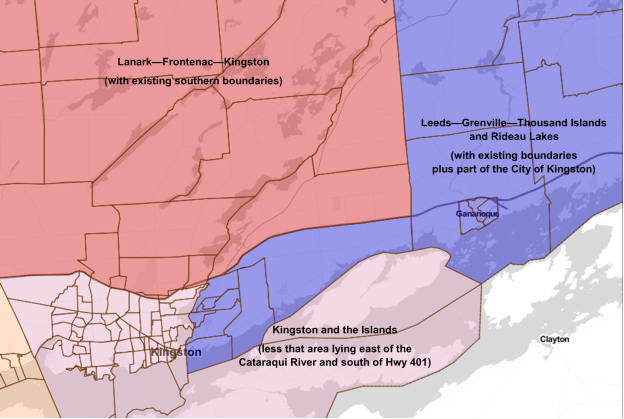Commentaire 98 – commentaires et rétroaction
Les documents ci-dessous sont affichés dans la langue officielle d'origine tels qu'ils ont été reçus.
Retour aux commentaires et rétroaction du public
Dennis Laurie
Re: Eastern Ontario — County Reunification
I propose that the Commission should re-unite the Eastern Ontario counties of Refrew, Frontenac, and the United Counties of Leeds and Grenville, and make two other changes. I submit that this proposal better solves the two problems that I presume the Commission encountered in Eastern Ontario, after adjusting the boundaries in and around Ottawa, in a way that better respects the current map, county and rural municipal boundaries, and Ontario's electoral quota.
The Commission's Initial Proposal
If I have interpreted the Commission's work accurately, the Commission first addressed the population deviation problems caused by the overpopulation of some Ottawa-area electoral districts, most especially in Orléans, Nepean, and the Carleton electoral district. This induced consequential domino effects to the surrounding districts in Eastern Ontario, travelling roughly from east of Ottawa to the northwest of Ottawa, and then south-southwest to the St. Lawrence.
The Commission, in its initial proposal, made changes in the Ottawa areas of Gloucester, Nepean, Kanata, and West Carleton that do a reasonable job of re-balancing the population deviations. However, the Commission was faced with an unmanageably large underpopulation problem in the existing district of Leeds–Grenville–Thousand Islands and Rideau Lakes. The Commission chose to address this problem, along with a less acute underpopulation problem in the current Lanark–Frontenac–Kingston district, by splitting up three counties and two municipalities, across three electoral districts, and engaging in a large population swap between Leeds–Grenville–Thousand Islands and Rideau Lakes and Lanark–Frontenac–Kingston. The Commission chose not to address the significant overpopulation problem of Kingston and the Islands at all.
My Proposal — County Reunification
My proposal is a much less drastic solution to this problem, and more effective relative to the electoral quota. It reunifies three counties the Commission proposes to divide (Renfew, Frontenac, Leeds and Grenville), changes existing boundaries to a lesser extent, addresses both the most acute under- and overpopulation problems in the area, and brings three of the six electoral districts in the Eastern Ontario area, as well as the area in the aggregate, much closer to Ontario's electoral quota than does the Commission's initial proposal. The average population of the districts in the Eastern Ontario area would be unchanged, and the range from most to least populous would be reduced by approximately half, from 16,322 and 14.00pp to 8,601 and 7.38pp.
The elements of my proposal, to the extent that it deviates from the Commission's initial proposal, are as follows:
- The southern boundary of the existing Lanark–Frontenac–Kingston district is restored, as are the boundaries of the existing Leeds–Grenville–Thousand Islands and Rideau Lakes district. This reunifies Frontenac County, reunifies South Frontenac Township, returns the area of the City of Kingston north of Highway 401 to the district in which it currently resides, reunifies the municipality of Elizabethtown-Kitley, and reunifies each of the municipalities of Elizabethtown-Kitley, Westport, Rideau Lakes, and Merrickville-Wolford with the United Counties of Leeds and Grenville.
- The area of the City of Kingston lying south of Highway 401 and east of the Cataraqui River is added to the boundaries of the existing Leeds–Grenville–Thousand Islands and Rideau Lakes district. This transfer addresses both the underpopulation problem of the existing Leeds–Grenville–Thousand Islands and Rideau Lakes district and the overpopulation problem of the existing Kingston and the Islands district, both of which are the most acute such problems in the Eastern Ontario area.
- The municipality of Greater Madawaska, in Renfrew County, is reunited with the rest of Renfrew County by inclusion in the proposed district of Algonquin–Renfrew–Pembroke.
Please see the table below for the population figures pursuant to my proposal. I have proposed an alternative name for the proposed district of Gananoque–Brockville–Prescott to reflect the boundaries I have proposed, namely "St. Lawrence–Rideau–Kingston". I have no strong feelings as to the name of this district, however.
| Existing Electoral Districts | Population, 2011 | Deviation from Quota 2012 | Population, 2021 | Deviation from Quota 2022 |
|---|---|---|---|---|
| Glengarry – Prescott – Russell | 106,240 | 0.02% | 116,463 | -0.11% |
| Lanark – Frontenac – Kingston | 98,424 | -7.33% | 111,424 | -4.43 |
| Leeds – Grenville – Thousand Islands and Rideau Lakes | 99,306 | -6.50% | 104,070 | -10.74% |
| Renfrew – Nipissing – Pembroke | 102,537 | -3.46% | 107,420 | -7.87% |
| Stormont – Dundas – South Glengarry | 100,913 | -4.99% | 104,493 | -10.38% |
| Average | 104,069 | -2.02% | 111,663 | -4.23% |
| Range | 18,572 | 17.48pp | 22,036 | 18.90pp |
| Existing Electoral Districts | Population, 2021 | Deviation from Quota 2022 |
|---|---|---|
| Prescott – Russell | 111,163 | -4.65% |
| Kingston and the Islands | 126,106 | 8.16% |
| Lanark – Frontenac | 109,784 | -5.84% |
| Gananoque – Brockville – Prescott | 113,266 | -2.85% |
| Algonquin – Renfrew – Pembroke | 116,900 | 0.27% |
| Stormont – Dundas – Glengarry | 114,637 | -1.68% |
| Average | 115,309 | -1.10% |
| Range | 16,322 | 14.00pp |
| Existing Electoral Districts | Population, 2021 | Deviation from Quota 2022 | Deviation Change vs Initial Proposal |
|---|---|---|---|
| Prescott – Russell | 111,163 | -4.65% | No change relative to quota |
| Kingston and the Islands | 112,307 | -3.67% | 4.49 pp closer to quota |
| Lanark – Frontenac – Kingston | 116,105 | -0.40% | 5.44 pp closer to quota |
| St. Lawrence – Rideau – Kingston | 117,869 | 1.10% | 1.75 pp closer to quota |
| Algonquin – Renfrew – Pembroke | 119,764 | 2.72% | 2.45 pp farther from quota |
| Stormont – Dundas – Glengarry | 114,637 | -1.68% | No change relative to quota |
| Average | 115,308 | -1.10% | No change relative to quota |
| Range | 8,601 | 7.38 | 6.62 pp narrower |
Kingston and the Islands
The district of Kingston and the Islands, as it exists now, and with no proposed change from the Commission, deviates in excess of the electoral quota to a greater extent than most districts in the Commission's initial proposal across Ontario; only seven other districts deviate in excess of the electoral quota to a greater extent. As proposed by the Commission, the district deviates from the electoral quota 40% more than does the next most deviating district in the Eastern Ontario area (Kingston and the Islands at +8.16% vs. Lanark–Frontenac at -5.84%). Its deviation in excess from the electoral quota (+8.16%) is substantially higher than the next highest deviation in excess in the area (Algonquin–Renfrew–Pembroke at +0.27%).
The City of Kingston is too large for a single electoral district, and has been for more than two decades, but its borders and population growth rates make it unlikely to grow large enough to merit two districts in the foreseeable future; the City's borders must, inevitably, give way.
The City's northern reaches, lying north of Highway 401, were previously removed from the Kingston and the Islands district in the 2012 redistribution process. My proposal effects a similar removal of another area of the City, that lying south of Highway 401 and east of the Cataraqui River. The result of this operation is to bring both of the existing, implicated districts (Kingston and the Islands, and Leeds–Grenville–Thousand Islands and Rideau Lakes) much closer to the electoral quota than the Commission has proposed to do.

